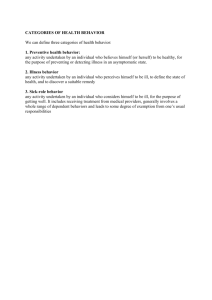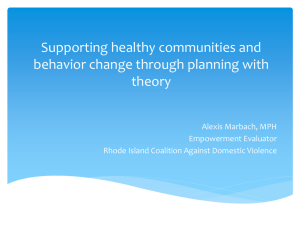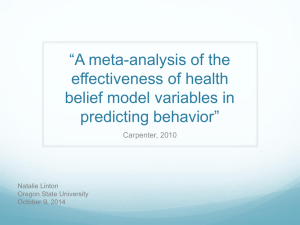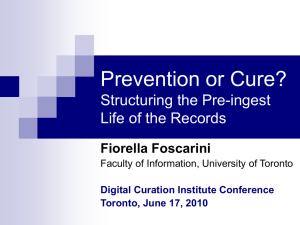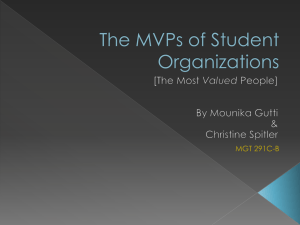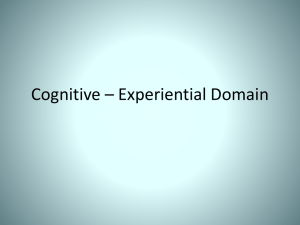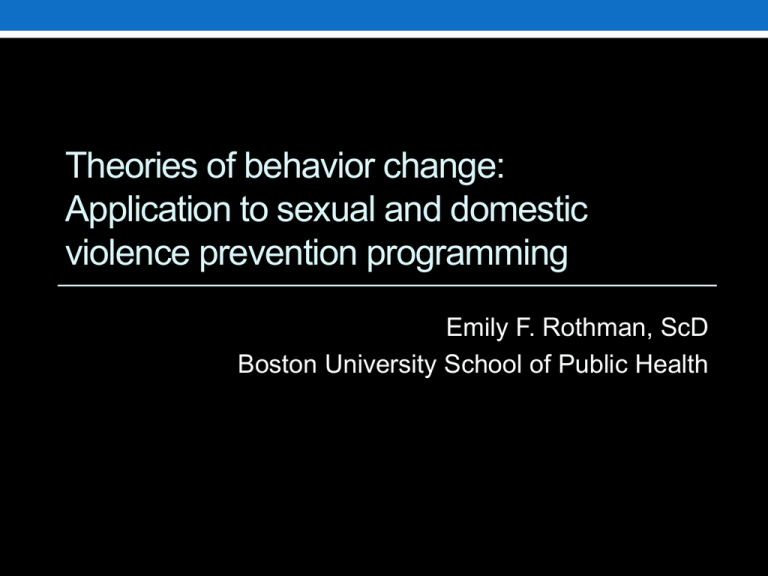
Theories of behavior change:
Application to sexual and domestic
violence prevention programming
Emily F. Rothman, ScD
Boston University School of Public Health
Agenda
1) What are theories of behavior change
(ToBC) and why do they matter?
2) Examples of ToBC success from other topics
3) Four leading ToBC theories
4) How to generate a program from a ToBC
5) Your questions/comments
3
The Dangers of Relying on Intuitive
Thinking and Common sense
4
What is the rationale?
5
• “It makes sense”
• “It sounds good”
• “It would have straightened me out”
• “They will be so scared that they’ll realize the
error of their ways”
• From the Web site: “Apart from becoming more
disciplined, the fear of coming back to the boot
camp will prevent teens from misbehaving
again.”
6
7
Putting Resources Behind Boot
Camps:
• Wastes money
• Doesn’t address the problem
• May make the problem worse
• Harms young people
8
Putting Resources Behind Boot
Camps:
• Wastes money
• Doesn’t address the problem
• May make the problem worse
• Harms young people
BEFORE WE THROW STONES…
HOW DO WE KNOW THAT WE AREN’T DOING THE
SAME THING?
An analysis of 18
different studies
found that school
programs that
promote physical
activity for kids
DO NOT reduce
their body mass
index
What’s the message?
Interventions
don’t always
work
What’s the message?
It doesn’t matter if you’re in
child health, substance abuse,
violence prevention…
we all face the same struggles
What’s the message?
Tax payers do not want to
pay for stuff that “seems
like a good idea”
but actually don’t do what
they are supposed to
What’s the message?
We are conscientious,
so we do not want to
spend our time
working on strategies
that have no effect
What’s so great about ToBC?
• They explain human behavior
• Theory-based health behavior
change programs are thought to be
more effective than those that do not
use theory
The Beer Experiment proves we’re crazy!
• Blind test: 59 percent of the participants
actually preferred the beer with vinegar to an
unadulterated glass of Sam Adams.
• In another test, however, in which participants
were told ahead of time which glass of beer
had vinegar in it, the proportion preferring the
vinegar beer dropped to 30 percent.
• give the same ice cream two different labels,
"low fat" and "regular fat," and people will say
the high-fat product tastes better. And they'll
eat more of it.
Lingo
• Sometimes we use the word “model” instead of theory
• Very minor differences between those things
• There are other kinds of theory in the world:
• Economic theory
• Physics theory (theory of relativity?)
• Social theory (Feminist theory, Marxist theory)
Today we are just talking about a handful of theories that can be
used to describe how and why people change their behavior.
20
Commonly Used Theories in Health Behavior
Research & Health Promotion Practice
• Health Belief Model
• Social Cognitive Theory
• Construct of Self-Efficacy
• Theory of Reasoned Action
• Theory of Planned Behavior
• Stages of Change/ Transtheoretical Model
• Precaution Adoption Process Model
Example of ToBC success
Problem: Lack of condom use
among sex workers
Individual factors: Workers low
perceived susceptibility and low
knowledge about HIV
Environmental constraint:
Perceived pimps attitudes’ towards
condoms use
Morisky DE, Pena M, Tiglao TV, et al. The impact of the work environment on condom use
among female bar workers in the Philippines. Health Educ Behav 2002; 29:461-472
Example of ToBC success
Theory: Diffusion of Innovation
How: Selected sex workers educate
peers about HIV
How: Educate bar managers about
importance of condoms
Example of ToBC in practice
Problem: Middle school youth
overweight and inactive
Individual factors: Didn’t prioritize
exercise; wasn’t on their radar
screen
Environmental constraint: Bad
gym facilities
Grim, ML & Pazmino-Cevallos, M. (2007). Using social cognitive theory in physical education: an example of the translation
of research into practice. The Journal of the Virginia Association for Health, Physical Education, Recreation and Dance.
Example of ToBC in practice
Theory: Social cognitive theory
How:
(1) Short education sessions (5-10 min)
(2) Self-monitoring with activity logs
(3) Goal-setting and rewarding yourself
(4) Newsletters to parents
(5) Fitness buddy
(6) Scavenger hunt for facilities
(7) Reflection on time spent per day
(8) Practice taking heart rate
(9) Tailoring for enjoyment
Social cognitive theory
Behavior
Person
Environment
Social cognitive theory
Behavior
Person
Opportunities
and social
support
Social cognitive theory
Behavior
Emotional coping
Self-efficacy
Problem solving skills
Expectations
Expectancies
Environment
Social cognitive theory
Reinforcements
Observational learning
Person
Environment
Health Belief Model
http://ww2.fhi.org/en/aids/aidscap/aidspubs/behres/bcr4theo.html
Background
(education, age, sex,
race/ethnicity)
Expectations
Perceived benefit of actions
Perceived barriers to action
Perceived self-efficacy to perform action
Threat
Perceived susceptibility to problem
Perceived severity of problem
Cues to action
Media
Personal influence
reminders
Behavior change
• SUSCEPTIBILITY: A person thinks a bad outcome (e.g.,
•
•
•
•
•
get sick or a disease) is likely to occur in the absence of
behavior change
SEVERITY: The consequence of the recommended action
is perceived to be severe as opposed to mild.
BELIEFS: He or she believes that the recommended
action will reduce the likelihood of the negative
consequences (e.g., disease)
BARRIERS: There are not significant psychological,
financial, or other costs or barriers to engaging in the
behavior.
CUES TO ACTION: There are internal or external
reminders to perform the recommended action
SELF-EFFICACY: The person feels strongly that he or she
is capable of taking the recommended action
• SUSCEPTIBILITY: A person thinks a bad outcome (e.g.,
•
•
•
•
•
get sick or a disease) is likely to occur in the absence of
behavior change
SEVERITY: The consequence of the recommended action
is perceived to be severe as opposed to mild.
BELIEFS: He or she believes that the recommended
action will reduce the likelihood of the negative
consequences (e.g., disease)
BARRIERS: There are not significant psychological,
financial, or other costs or barriers to engaging in the
behavior.
CUES TO ACTION: There are internal or external
reminders to perform the recommended action
SELF-EFFICACY: The person feels strongly that he or she
is capable of taking the recommended action
• SUSCEPTIBILITY: A person thinks a bad outcome (e.g.,
•
•
•
•
•
get sick or a disease) is likely to occur in the absence of
behavior change
SEVERITY: The consequence of the recommended action
is perceived to be severe as opposed to mild.
BELIEFS: He or she believes that the recommended
action will reduce the likelihood of the negative
consequences (e.g., disease)
BARRIERS: There are not significant psychological,
financial, or other costs or barriers to engaging in the
behavior.
CUES TO ACTION: There are internal or external
reminders to perform the recommended action
SELF-EFFICACY: The person feels strongly that he or she
is capable of taking the recommended action
• SUSCEPTIBILITY: A person thinks a bad outcome (e.g.,
•
•
•
•
•
get sick or a disease) is likely to occur in the absence of
behavior change
SEVERITY: The consequence of the recommended action
is perceived to be severe as opposed to mild.
BELIEFS: He or she believes that the recommended
action will reduce the likelihood of the negative
consequences (e.g., disease)
BARRIERS: There are not significant psychological,
financial, or other costs or barriers to engaging in the
behavior.
CUES TO ACTION: There are internal or external
reminders to perform the recommended action
SELF-EFFICACY: The person feels strongly that he or she
is capable of taking the recommended action
• SUSCEPTIBILITY: A person thinks a bad outcome (e.g.,
•
•
•
•
•
get sick or a disease) is likely to occur in the absence of
behavior change
SEVERITY: The consequence of the recommended action
is perceived to be severe as opposed to mild.
BELIEFS: He or she believes that the recommended
action will reduce the likelihood of the negative
consequences (e.g., disease)
BARRIERS: There are not significant psychological,
financial, or other costs or barriers to engaging in the
behavior.
CUES TO ACTION: There are internal or external
reminders to perform the recommended action
SELF-EFFICACY: The person feels strongly that he or she
is capable of taking the recommended action
• SUSCEPTIBILITY: A person thinks a bad outcome (e.g.,
•
•
•
•
•
get sick or a disease) is likely to occur in the absence of
behavior change
SEVERITY: The consequence of the recommended action
is perceived to be severe as opposed to mild.
BELIEFS: He or she believes that the recommended
action will reduce the likelihood of the negative
consequences (e.g., disease)
BARRIERS: There are not significant psychological,
financial, or other costs or barriers to engaging in the
behavior.
CUES TO ACTION: There are internal or external
reminders to perform the recommended action
SELF-EFFICACY: The person feels strongly that he or she
is capable of taking the recommended action
Jane is likely to quit smoking because…
• She thinks that she might get lung cancer if she
continues to smoke (high susceptibility).
• She believes that dying from lung cancer is terrible
(high severity).
• She would feel happier if her hair and clothes didn’t
always smell like smoke, and it would save her
money too (multiple benefits to quitting).
• Her friends are supportive of her quitting, and her
company has a free cessation program (few barriers
to quitting).
CREDIT: gim.med.ucla.edu/FacultyPages/.../Theory%20and%20Behavior.ppt
Jon is not likely to quit smoking
because…
• He agrees with the tobacco industry--smoking
doesn’t cause lung cancer (low susceptibility).
• He believes that dying from lung cancer is not any
worse than any other way of dying (neutral
severity).
• Jon feels that smoking relaxes him (few benefits to
quitting).
• He’s a musician and everyone in his band smokes,
he also feels that smoking makes his voice sound
better (multiple barriers to quitting)
CREDIT: gim.med.ucla.edu/FacultyPages/.../Theory%20and%20Behavior.ppt
Using the Health Belief Model
Construct
What to do
Perceived severity
Provide messages about the serious personal impacts
(medical and social) of the problem
Perceived susceptibility Provide messages or activities to personalize risk for
individuals based on behavior or self-assessment tools
Perceived benefits
Provide messages about benefits of engaging in a
behavior to reduce risk based on scientific evidence on the
efficacy of the behavior
Perceived barriers
Identify and reduce perception of barriers to engage in the
action. Correct misperceptions. Example: I won’t learn
anything useful at parenting workshop and I will just get
depressed
Self-efficacy
Messages that provide guidance on how to make behavior
easy to do
Stages of change (Transtheoretical model)
Precontemplation
Consciousness raising
Dramatic relief
Environmental reevaluation
Contemplation
Self re-evaluation
Preparation
Self liberation
Action
Reinforcement management
Helping relationships
Counter-conditioning
Stimulus control
Maintenance
Stages of change (Transtheoretical model)
http://info.k4health.org/pr/j56/4.shtml
Precaution Adoption Process Model
Stage 1: Unaware
Media messages get you to the next stage
Stage 2: Unengaged
Personal experiences or significant
others move you forward
Stage 3: Deciding about acting
Stage 4: Decided not to act
Stage 5: Decided to act
Stage 6: Acting
Stage 7: Maintenance
Precaution Adoption Process Model
Do you know what “dating violence” means?
No = {stage 1} = teach about what counts as dating abuse
Yes= go to next stage
Do you currently intervene with friends when you observe
unhealthy relationship behavior?
No= stage 2= teach about how to intervene
Yes = go to next stage
Which of the following best describes you?
I’ve never thought about intervening. {Stage 2}
I’m undecided about it. {Stage 3}
I’ve decided I don’t want to. {Stage 4}
I’ve decided I do want to. {Stage 5}
Theory of Reasoned Action (the original)
Belief that the behavior leads to
desired outcomes
=Attitude towards the behavior
Valuing the outcomes
Intention
Beliefs about whether other
people you to do the behavior
=Subjective norm
Valuing the opinions of those
people
Behavior
Theory of Planned Behavior (the Part 2)
Belief that the behavior leads to
desired outcomes
=Attitude towards the behavior
Valuing the outcomes
Beliefs about whether other
people you to do the behavior
Intention
=Subjective norm
Valuing the opinions of those
people
Perceived power to make
behavior change
Control over own behavior
Behavior
Theory of Planned Behavior (the Part 2)
Belief that the behavior leads to
desired outcomes
=Attitude towards the behavior
Valuing the outcomes
Beliefs about whether other
people you to do the behavior
Intention
=Subjective norm
Valuing the opinions of those
people
Perceived power to make
behavior change
Control over own behavior
Behavior
Summing up: 8 lessons learned
the person must…
1 have a strong positive intention to perform the behavior
(have the right attitude)
2 Face few environmental constraints
3 Have the skills needed to do the new behavior
4 Believe the benefits will outweigh the costs & risks
5 Believe that there is peer pressure to change
6 Believe the new behavior fits their self-image
7 Feel emotionally ready and happy to make a change
8 Feel capable of making the change (not like a failure)
Summing up: 8 lessons learned
the person must…
1 have a strong positive intention to perform the behavior
(have the right attitude)
2 Face few environmental constraints
3 Have the skills needed to do the new behavior
4 Believe the benefits will outweigh the costs & risks
5 Believe that there is peer pressure to change
6 Believe the new behavior fits their self-image
7 Feel emotionally ready and happy to make a change
8 Feel capable of making the change (not like a failure)
How to generate a program from a ToBC
• Read the theory; all about the theory
• Read examples of other programs born from that theory
• Start jotting down ideas
• Use a translation grid
Example translation grid
Theoretical concept
Program objective
Program activity
Belief that behavior
leads to desirable
outcome
Make Newport residents (1) Show example of
believe that intervening
community where it
when they see DV or a
worked
sexist joke will make
(2) Show how bad it is in
Newport a better place to
Newport
live:
(1) Your experience in
Newport will be safer
(2) People/tourists will be
safer and happier in
Newport
(3) Make it safer for your
sister and daughter to
date in Newport
(4) Pride in 5th ward
Example translation grid: dating abuse using Health
Belief Model
Theoretical
concept
Program objective
Program activity
Susceptibility
Boys believe they could be perpetrators
if they aren’t careful
Are you a potential
perpetrator quiz
Perceived severity
Boys understand being a perpetrator is
a bad, undesirable thing
Video about
consequences
Perceived benefits
Boys understand that being healthy gets Girls’ panel about
you more respect and love
good boyfriends
Perceived barriers
Boys afraid to be called gay for being
gentle or non-violent
Boy leaders speak
out
Cues to Action
Boys primed to change with posters &
events
Posters and pledge
drive, bracelets
Self-efficacy
Boys provided with training so they
believe that they can do it & practice
Education and role
plays; rewards for
achievement
Example translation grid
Theoretical concept
Program objective
Program activity
More reading
http://www.csupomona.edu/~jvgrizzell/best_practices/bctheory.html
http://siteresources.worldbank.org/EXTGOVACC/Resources/BehaviorChangew
eb.pdf
http://www.fhi.org/nr/rdonlyres/ei26vbslpsidmahhxc332vwo3g233xsqw22er3vof
qvrfjvubwyzclvqjcbdgexyzl3msu4mn6xv5j/bccsummaryfourmajortheories.pdf

